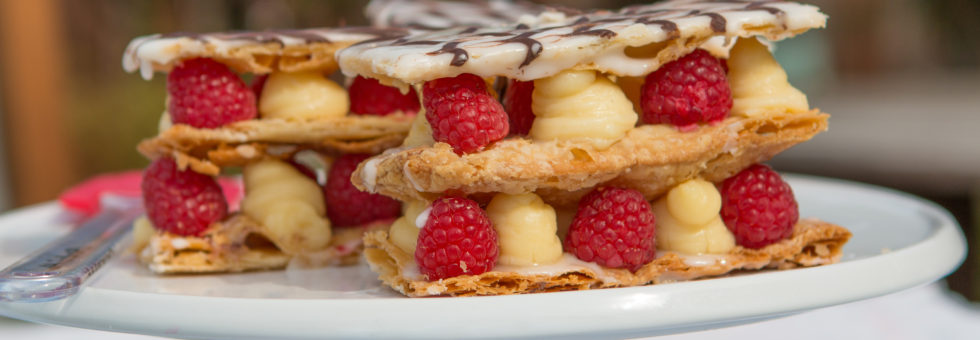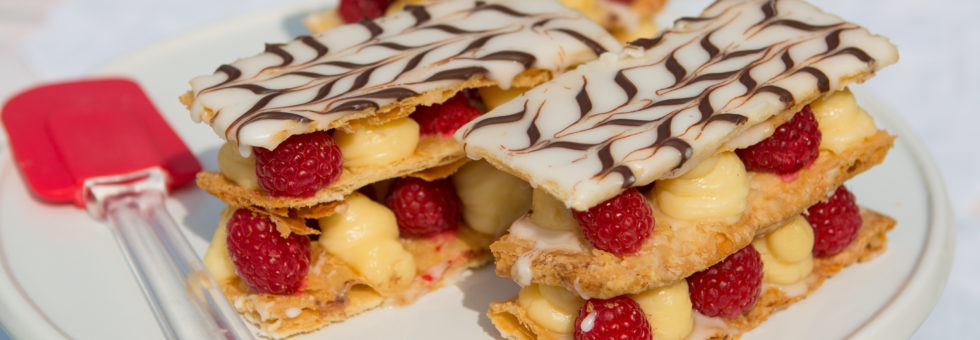For this week’s bake I chose a Spanish milhojas recipe, a pastry we often refer to in the French: millefeuiile, also known as a vanilla slice or custard slice. Millefeuille is French for 1000 layers, in reference to the many layers of puff pastry. The Spanish, milhojas, means the same. The Spanish word “hoja” and French word “feuille” mean both leaf and sheet (or specifically layer in this case). In fact, many other languages have just one word for both these meanings, whereas English has at least two.
Baking
The website where I found this recipe had a helpful video to follow. In fact, this inspired me to create my own amateur hyperlapse version, which I’ve included below. As you will see, millefeuille all starts with puff pastry, which is baked on its own and then sliced up to form layers, between which a classic vanilla crème patissière is sandwiched. I decided to turn my recipe into a fruitier version and include raspberries. It is all topped with icing and some feathering decoration, which was a new technique for me.
The recipe was ranked as difficult, but since it was one of my all-time favourite desserts, that wasn’t going to stop me. The puff pastry is supposed to be relatively flat when baked, helped by pricking the pastry, but mine turned out to be pretty bumpy when cooked and not the strongest of bases for forming sturdy layers. I’ve seen some recipes which advise placing a baking tray on top of the pastry to prevent it from rising. which seems a sensible approach to take in the future.
As for cutting the millefeuille into slices, this was something I wasn’t looking forward to and I couldn’t imagine how it would all stay together. However, I came across this video which recommends cutting the top two layers into individual portions beforehand, but not the base. This allows you the benefit of decorating the top as a single piece, while only having to cut through the base layer to form portions. Win-win.
Translation
The pastry recipe recommends using “mantequilla para pastelería”, i.e. butter for pastry. It is unclear what this refers to specifically. Does this mean butter as opposed to margarine? Unsalted butter instead of salted? For puff pastry, butter with a higher melting point (such as Normandy butter) is usually recommended to prevent the butter from melting as it is being handled, but in these times of scarcity I wasn’t going to be too picky and I went with my usual unsalted butter.
Pricking the pastry
Before baking, the puff pastry needs to be pricked with a fork. There is actually a technical term used for this technique in English: “to dock” the pastry. However, the terminology isn’t common knowledge other than in patisserie circles and it is likely that a layperson using the recipe wouldn’t understand this, so I described it as “prick the base”, as usually seen in recipe books. This technique is used to allow steam out of the pastry while cooking in order to prevent it from rising, thus forming a flatter puff pastry sheet (if you’re lucky!). In many other puff pastry dishes you want the pastry to rise, displaying its beautiful layers in all their glory, but for millefeuille, and particularly this crunchy version of the recipe, it needs to remain as thin as possible.

Feathered finish
The millefeuille features a feathered decoration. This has been described in the Spanish step by step, but since we have the term “feathering” in English, it is worth including in the recipe so the audience knows exactly what it should look like (even if they don’t know how to do it, this is also explained). It’s helpful to be able to pick out specific terminology in English, even where there isn’t such a term in the source language, as it helps clarify the meaning for the reader.
Overall
By delicately balancing raspberries and crème patissière, I was able to just about overcome the challenge of uneven layers of pastry and produce both upright and free-standing millefeuilles. I will definitely be making these again, perhaps with a different combination of flavours for variety.
Next week it’s time for a tricky French delicacy which took me a lot of practice…



